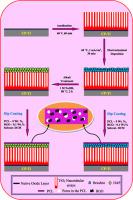当前位置:
X-MOL 学术
›
J. Alloys Compd.
›
论文详情
Our official English website, www.x-mol.net, welcomes your
feedback! (Note: you will need to create a separate account there.)
Development of novel multi-functional composite coatings on titanium: Evaluation of structural characteristics, bioactivity and corrosion behaviour
Journal of Alloys and Compounds ( IF 5.8 ) Pub Date : 2021-02-01 , DOI: 10.1016/j.jallcom.2020.157290 S.A. Iynoon Jariya , K. Ravichandran , T.S.N. Sankara Narayanan
Journal of Alloys and Compounds ( IF 5.8 ) Pub Date : 2021-02-01 , DOI: 10.1016/j.jallcom.2020.157290 S.A. Iynoon Jariya , K. Ravichandran , T.S.N. Sankara Narayanan

|
Abstract A multi-functional coating approach involving a sequence of surface modification is proposed to improve the corrosion resistance and bioactivity of Ti. Development of TiO2 nanotubular (TNT) arrays on Ti using ethylene glycol + 0.4 wt % NH4F + 10 wt % deionized water at 60 V for 60 min was employed as the first stage treatment. Electrodeposition of brushite over TNT arrays using 0.1 M Ca(NO3)2 + 0.06 M NH4H2PO4 at 1 mA/cm2 for 45 min was used as the second stage treatment. Some of the brushite coated TNT arrays were subjected to alkaline treatment using 1.0 M NaOH at 80 °C for 2 h to covert the brushite into hydroxyapatite (HAP) coating. Deposition of reduced graphene oxide/polycaprolactone (RGO/PCL) composite coating by dip coating method was adopted as the third and final stage treatment. The RGO/PCL composite coating is deposited over both brushite and HAP coated TNT arrays. The coatings formed at various stages were characterized for their morphological features, phase content and nature of functional groups. The corrosion behaviour of these coatings was determined by potentiodynamic polarization studies. The bioactivity of multi-functional composite coating was determined by immersing it in simulated body fluid (SBF) solution at 37 °C for 168 h while their long-term stability was determined by immersing it in HBSS at 37 °C for 21 days. The findings of the study reveal that the novel multi-functional composite coating on Ti is promising for bone tissue engineering.
中文翻译:

在钛上开发新型多功能复合涂层:评估结构特性、生物活性和腐蚀行为
摘要 提出了一种涉及一系列表面改性的多功能涂层方法,以提高钛的耐腐蚀性和生物活性。使用乙二醇 + 0.4 wt% NH4F + 10 wt% 去离子水在 60 V 下开发 TiO2 纳米管 (TNT) 阵列在 Ti 上被用作第一阶段处理。使用 0.1 M Ca(NO3)2 + 0.06 M NH4H2PO4 以 1 mA/cm2 在 TNT 阵列上电沉积透钙磷石 45 分钟用作第二阶段处理。一些透钙磷石涂覆的 TNT 阵列在 80°C 下使用 1.0 M NaOH 进行碱处理 2 小时,以将透钙磷石转化为羟基磷灰石 (HAP) 涂层。采用浸涂法沉积还原氧化石墨烯/聚己内酯(RGO/PCL)复合涂层作为第三阶段也是最后阶段的处理。RGO/PCL 复合涂层沉积在透钙磷石和 HAP 涂层的 TNT 阵列上。在不同阶段形成的涂层的特征在于它们的形态特征、相含量和官能团的性质。这些涂层的腐蚀行为由动电位极化研究确定。多功能复合涂层的生物活性通过将其浸入 37°C 的模拟体液 (SBF) 溶液中 168 小时来确定,而其长期稳定性则通过将其浸入 37°C 的 HBSS 中 21 天来确定。研究结果表明,Ti 上的新型多功能复合涂层有望用于骨组织工程。官能团的相含量和性质。这些涂层的腐蚀行为由动电位极化研究确定。多功能复合涂层的生物活性通过将其浸入 37°C 的模拟体液 (SBF) 溶液中 168 小时来确定,而其长期稳定性则通过将其浸入 37°C 的 HBSS 中 21 天来确定。研究结果表明,Ti 上的新型多功能复合涂层有望用于骨组织工程。官能团的相含量和性质。这些涂层的腐蚀行为由动电位极化研究确定。多功能复合涂层的生物活性通过将其浸入 37°C 的模拟体液 (SBF) 溶液中 168 小时来确定,而其长期稳定性则通过将其浸入 37°C 的 HBSS 中 21 天来确定。研究结果表明,Ti 上的新型多功能复合涂层有望用于骨组织工程。
更新日期:2021-02-01
中文翻译:

在钛上开发新型多功能复合涂层:评估结构特性、生物活性和腐蚀行为
摘要 提出了一种涉及一系列表面改性的多功能涂层方法,以提高钛的耐腐蚀性和生物活性。使用乙二醇 + 0.4 wt% NH4F + 10 wt% 去离子水在 60 V 下开发 TiO2 纳米管 (TNT) 阵列在 Ti 上被用作第一阶段处理。使用 0.1 M Ca(NO3)2 + 0.06 M NH4H2PO4 以 1 mA/cm2 在 TNT 阵列上电沉积透钙磷石 45 分钟用作第二阶段处理。一些透钙磷石涂覆的 TNT 阵列在 80°C 下使用 1.0 M NaOH 进行碱处理 2 小时,以将透钙磷石转化为羟基磷灰石 (HAP) 涂层。采用浸涂法沉积还原氧化石墨烯/聚己内酯(RGO/PCL)复合涂层作为第三阶段也是最后阶段的处理。RGO/PCL 复合涂层沉积在透钙磷石和 HAP 涂层的 TNT 阵列上。在不同阶段形成的涂层的特征在于它们的形态特征、相含量和官能团的性质。这些涂层的腐蚀行为由动电位极化研究确定。多功能复合涂层的生物活性通过将其浸入 37°C 的模拟体液 (SBF) 溶液中 168 小时来确定,而其长期稳定性则通过将其浸入 37°C 的 HBSS 中 21 天来确定。研究结果表明,Ti 上的新型多功能复合涂层有望用于骨组织工程。官能团的相含量和性质。这些涂层的腐蚀行为由动电位极化研究确定。多功能复合涂层的生物活性通过将其浸入 37°C 的模拟体液 (SBF) 溶液中 168 小时来确定,而其长期稳定性则通过将其浸入 37°C 的 HBSS 中 21 天来确定。研究结果表明,Ti 上的新型多功能复合涂层有望用于骨组织工程。官能团的相含量和性质。这些涂层的腐蚀行为由动电位极化研究确定。多功能复合涂层的生物活性通过将其浸入 37°C 的模拟体液 (SBF) 溶液中 168 小时来确定,而其长期稳定性则通过将其浸入 37°C 的 HBSS 中 21 天来确定。研究结果表明,Ti 上的新型多功能复合涂层有望用于骨组织工程。









































 京公网安备 11010802027423号
京公网安备 11010802027423号